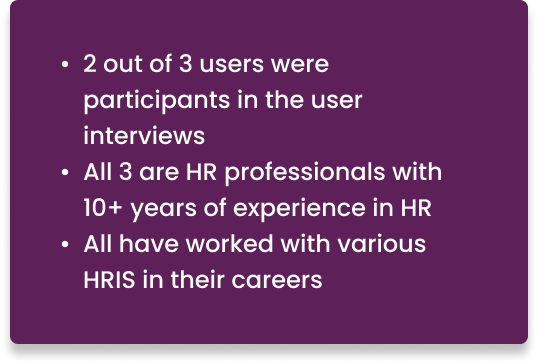
Case Study
SeresaHR
End-to-End Design
Human resources information system incorporating generative AI
PROJECT OVERVIEW
SeresaHR
Human Resource Information Systems (HRIS) play a crucial role in enabling People and HR teams to efficiently carry out their tasks, enhancing their understanding of their workforce. As a former HR professional with experience in diverse HRIS platforms, creating a comprehensive solution to address the challenges faced by my former colleagues and me would be a fantastic opportunity to merge my two worlds.
PROBLEM EXPLORATION
What areas of HRIS can be improved?
HRIS is a critical tool for how HR and People teams understand their employees. Often times, the design of these systems can lead to inefficiencies and frustration, which removes practitioners from being able to focus on high-value, strategic work.
RESEARCH
Goal: Find a solution to alleviate the routine tasks encountered by HR professionals on a daily basis.
As HR and People teams are inherently focused on interacting with individuals within organizations, there are a certain number of repetitive tasks and requests that consistently fall under our responsibilities, regardless of your position in your HR career.
OBJECTIVES:
Identifying areas of support within the daily operations of HR
Understanding likes/dislikes of users regarding current and past HRIS
Where can artificial intelligence play a part in the solution?
METHODS:
Competitor analysis
User interviews
COMPETITOR ANALYSIS
USER INTERVIEWS
-
What areas in your job do you feel like you need support the most?
In the area(s) you named, what tasks are the most time consuming?
If you had the ability to design your own HRIS, what features would you implement and why?
What areas of HR management do you think generative AI could add the most value?
GENERAL THEMES
PROBLEM DEFINITION
HRIS lacks an effective mechanism for addressing employee questions promptly and effectively.
Solution: AI-Powered Chatbot in HRIS for Addressing Employee Queries
HR professionals often find themselves spending a substantial amount of time addressing routine employee questions, which can divert their attention away from more strategic work that could bring more value to the organization.
PRODUCT ROADMAP
While there are numerous aspects to consider when designing an HRIS, I had to prioritize the ones that would help reduce time-consuming tasks due to the project's time constraints. Responding to employee inquiries topped this list.
TASK FLOWS
LOW FIDELITY WIREFRAMES
DESIGN PIVOT
These screens showcase the style and branding before I shifted my focus. I got some feedback suggesting a more fun and playful direction. While I do enjoy infusing that energy into my designs, my original intention was to lean towards a more corporate or enterprise look, wanting to steer away from the usual blue and white scheme often seen in software products. I aimed for a balance that felt both inviting and approachable.
DESIGN SYSTEM + BRANDING
Aesthetic: make it friendly, but let’s mean business!
There was a shift in the design direction where I was progressing towards a more playful aesthetic. I needed to gear towards a more enterprise-grade look.
HIGH-FIDELITY WIREFRAMES
I believed that employing a range from deep purple to light purple achieved this, along with incorporating some sharper elements and opting for a font with a slightly more serious tone. These adjustments, in my view, successfully conveyed that vibe.
USER TESTING
The user testing outcomes showed an almost perfect pass rate.
TEST PARTICIPANTS
USER FEEDBACK
Overall, users found the task flows pretty straight forward and uncomplicated. Among the prevalent feedback was the suggestion to enhance the HR admin's inquiry ticketing experience. Does the process conclude once the admin responds to the inquiry? Or is there an opportunity for further follow-up until the employee is content with the provided response?
ITERATIONS
FINAL PROTOTYPE
EMPLOYEE TASK FLOW
HR ADMIN TASK FLOW
REFLECTION
Developing an HRIS has been a convergence of my two professional realms. Throughout my HR career, I've interacted with various systems. While they undoubtedly enhance our work, I've also grappled with the limitations of off-the-shelf solutions that lack the customization required to align with each organization's unique needs. Given the distinctiveness of every organization, a one-size-fits-all approach can be quite challenging. This is precisely where artificial intelligence emerges as a potential game-changer, poised to revolutionize these systems. If only the project's scope extended beyond the initial four weeks, I would relish the opportunity to continue crafting solutions with AI integration in mind, spanning areas such as report generation, benefits administration, performance management, and much more.




















